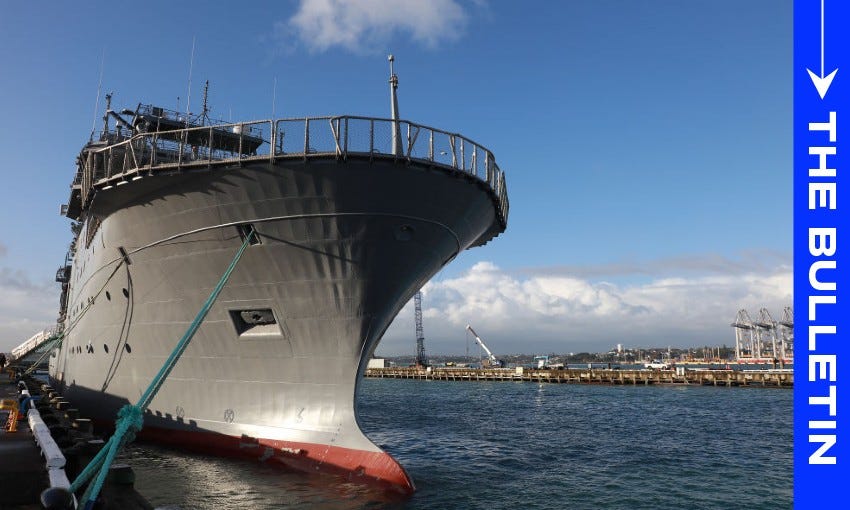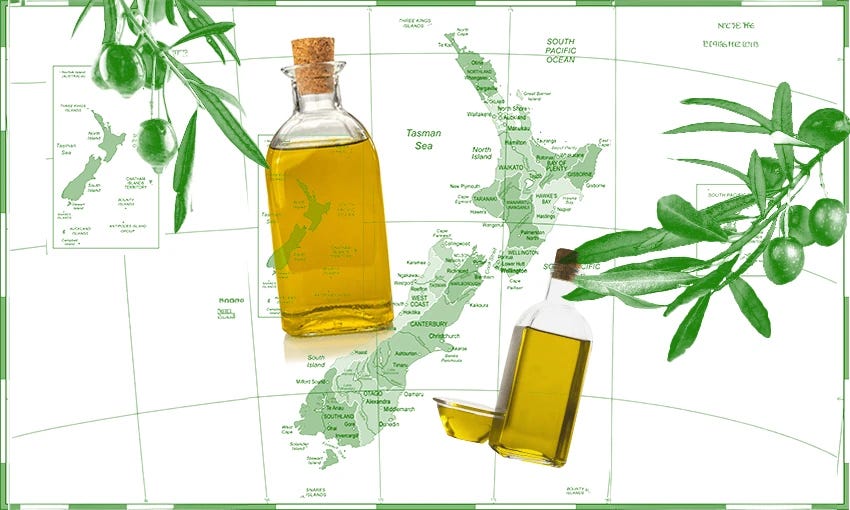An ecological disaster looms off the coast of Samoa
While reports of oil leaking from the capsized Manawanui may be unfounded, that doesn't mean the wreckage won't cause lasting damage.
Mōrena, and welcome to The Bulletin for Wednesday, October 9.
In today’s edition: Health NZ’s financial situation could be worse than previously forecast, will the official cash rate by cut by a supersized 50 basis points, and Christopher Luxon jets off to the East Asia Summit. But first, a check in with the ongoing recovery efforts after HMNZS Manawanui capsized over the weekend.

Fuel, oil or something else?
Immediately following the sinking of HMNZS Manawanui over the weekend, attention was on ensuring all 75 people onboard were safe. The crew and passengers of the ill-fated vessel arrived back in New Zealand late on Monday night, with a full inquiry to determine what exactly went wrong. But with no lives lost, all eyes are now on the emerging ecological disaster unfolding off the coast of Samoa.
The Samoa Observer reported yesterday that oil can be seen floating on the top of the water above the wreckage, with rubbish and other debris “threatening marine life, food sources and tourism in the area”. Despite these reports, the Samoa government says there have been no confirmed oil leaks yet, though the presence of the wreckage would still pose a serious threat to marine life. Speaking to RNZ’s Checkpoint last night, Navy commodore Shane Arndell explained that while the Manawanui was resting 30 metres underwater on a reef, it was not leaking. "The divers went out… to survey the ship ... and from what they've reported there has been nothing leaking from the ship once it sunk,” he said. A lot of liquid leaked from the ship as it was sinking, said Arndell, but that had now stabilised.
The challenge ahead
The capsizing happened over the weekend – Stuff has a full timeline of the events here – but the clean up remains an evolving situation. Whether oil is leaking now or not, speed remains of the essence, wrote Waikato University’s Christopher Battershill for The Conversation. “There’s only a narrow window of time to seal any fuel leaks – and, ideally, pipe out more than 900 tonnes of marine diesel the ship carries,” he said.
But it’s not just the fuel. Crushed coral and contaminated sediment around the wreckage needs to be cleared in case it has come into contact with the ship’s “anti-fouling” paint, which can be toxic. As RNZ reported, the Manawanui carried several “marine-standard chemicals” onboard, though they claim there were no hazardous chemicals "beyond those that would be carried by most commercial ships." The Herald has reported that sea turtles have been found dead on the shoreline near the wreckage, prompting concern about further ecological damage being done beneath the surface.
Echoes of the Rena
The first point of reference for many people when they hear of a sunken ship ands the threat of an oil spill is likely the Rena, which struck a reef off the Tauranga coast in 2011. This Stuff feature to mark the 10th anniversary of the disaster described it as our biggest maritime disaster. Oil leaks caused “blackened beaches”, while the reef was littered with debris “including smashed containers”.
The good news, argued Waikato University’s Nick Ling in comments via the Science Media Centre, is that the fuel onboard the Manawanui is lighter and potentially less damaging than the crude oil that leaked out of the Rena. “Much of that light fuel material will quickly evaporate or disperse, so although it is toxic and will potentially affect the immediate reef environment, any damage is likely to be quite localized,” said Ling.
What happens next?
A full court of inquiry has been established to determine what may have caused the Manawanui to capsize. The Post’s Amelia Wade reported that the final details of this could, however, be kept secret – though Act Party leader David Seymour has urged for transparency. “I think the critical thing we need to find out is what this means for our defence capability, and New Zealanders deserve to know whether this disaster was the result of underinvestment,” Seymour said.
Speaking to Newstalk ZB yesterday morning, rear admiral Garin Golding said speculation on the cause was unhelpful, though defence minister Judith Collins has confirmed the ship lost power. Whether or not the wreckage can be recovered remains to be seen, though locals want swift action regardless. “Even if the immediate risk didn't seem to be such a serious problem, it does not mean that risk is gone, because there is going to be quite a lot of oil in that boat to think about,” Samoa Conservation Society president James Atherton told RNZ’s Checkpoint.
Join our community of supporters
"I like that it feels like chipping in for a good cause, rather than paying for a subscription." – Kimberley, Spinoff member.
Whether you read, listen to or watch our mahi, you can support us to do more by donating today or signing up to become a member. Already a member? Ka nui te mihi, your support means the world to us.
Te Whatu Ora heading for higher deficit than forecast
Health NZ has opened its books, revealing its deficit could reach almost $1.8bn by the end of the financial year, reports Rachel Thomas at The Post. That’s higher than the $1.4bn that was originally feared. “Without interventions Health NZ is estimated to continue to lose about $147 million every month, which would lead to a projected deficit of $1.76 billion by 30 June 2025,” the documents, made public yesterday, confirm.
The agency hopes it can “break even”, however, by making $900m of cuts in the year to June and a further $500m in the following year, Stuff’s Bridie Witton reported. While promising not to cut any frontline roles, the agency wants to reduce the number of chief medical officers.
Meanwhile, as the Herald reported, the documents also showed that Health NZ’s former board strongly rejected allegations the agency wasn’t on top of its finances. Instead, growth in the nursing workforce was said to be putting pressure on the budget and, in late June, Health NZ said it would be restricting nursing recruitment to “clinical risk areas” and areas covered by the government’s national health targets.
Watch: Home Education, episode one
Home Education begins on a pick-your-own dahlia farm. Three years ago, Jen gave her children $100 to start a business as a learning project. Having fallen in love with dahlias, Gracie spent her money on some dahlia plants. Today, they have a thriving dahlia farm with almost 4,000 plants. “It’s a beautiful way to live,” says Jen. Now, the farm is a classroom. Gracie, Milly and Lexie learn maths at the till counting out change for customers, science while testing different options for flower food and art as they market their flowers.
Made with the support of NZ On Air.
How far will the Reserve Bank go?
Kiwibank has reduced its variable home loan rates by 0.50% in anticipation of a similar move to the official cash rate later today, reported 1News. It’s now widely expected the Reserve Bank will choose to make a more significant 50 basis point cut to the OCR, with the possibility of another before the end of the year. As Stuff’s Esther Taunton reported, some are even picking a radical 75 basis point cut today – though this seems unlikely.
Writing for his Inside Economics column on the Herald (paywalled), Liam Dann noted that while economists widely agree that a 50 basis point cut is likely, it will be a close call. “In the end, it will come down to an RBNZ judgment on just how grim the economy really is right now,” said Dann. We’ll find out where the Reserve Bank has landed at 2pm.
Where creative, content, and technology intersect
We’re Daylight: a technology and creative studio that helps brands and organisations stand out in a digital-first world. Born in a newsroom, we understand how to adapt to a rapidly changing media landscape. Whether crafting dynamic campaigns, producing engaging content, or developing innovative digital products, we enable clients to connect more authentically with audiences. With every project, we blend strategy, creativity, and technology to produce results that make an impact.
Click and Collect
Complaints about officials, boring council meetings, mutual praise: Texts between Simeon Brown and Wayne Brown released.
Act Party leader David Seymour faced off against iwi leader Helmut Modlik in a debate on Te Tiriti o Waitangi. Relive it via our live blog from last night.
A scoop from Newstalk ZB’s Azaria Howell reveals the resignation letter from a former Kāinga Ora board member that criticised Bill English’s review of the agency. (NZ Herald Premium, paywaled)
When the flood came for South Dunedin, this time it was ready.
Why Christopher Luxon’s trip to the East Asia Summit is a “hugely valuable opportunity”.
KiwiRail cost cutting set to cost jobs and services across the North Island.
Struggling GP practice claims Health NZ committee told it to start cafe to bring in cash.
The number of dog welfare-related complaints has spiked by 80% in Auckland over the past year.
Join us for a one-night only live event
We’re huge fans of local television here at The Spinoff, and for one night only we want to celebrate some of our all-time faves. Join Alex Casey, Kura Forrester, Rhiannon McCall, Stewart Sowman-Lund and Lyric Waiwiri-Smith at Q Theatre on October 31 as we unearth some beloved TV gems and argue for their place in our history.
Olive oil costs heaps at the moment; Madeleine Holden wonders if local retailers can come to the rescue. Unity children's booksellers review their favourite books for spring. The Spinoff Guide to Life has some useful ideas for not being a menace in a public pool. Shanti Mathias discovers some pertinent numbers in the list of fast-tracked projects. For The Cost of Being, a graduate working for a NGO explains the cost of chronic health issues.
That’s it for this morning, thanks for reading. I’ll catch you back tomorrow.
Want to get in touch? Join the conversation in the Substack comments section or via email at thebulletin@thespinoff.co.nz if you have any feedback on today’s top stories (or anything else in the news).
If you liked what you read today, share The Bulletin with friends, family and colleagues.















Am I missing something re: Te Whatu Ora funding?
It seems to me that the budget “blowout” is mostly because of hiring new nurses. If that hasn’t been budgeted for, why not? How is the crises in the health sector meant to be solved without enough funding for the very things required to solve it? It appears that the so called budget blowout is actually underfunding.
😱🤔"Health NZ has opened its books, revealing its deficit could reach almost $1.8bn by the end of the financial year, reports Rachel Thomas at The Post. That’s higher than the $1.4bn that was originally feared. “Without interventions Health NZ is estimated to continue to lose about $147 million every month, which would lead to a projected deficit of $1.76 billion by 30 June 2025,” the documents, made public yesterday, confirm. "
FFS 🤬 it is NOT a" deficit" - it is UNDERFUNDING COMPARED TO PREVIOUS PER CAPITA SPENDING & a deliberate choice by the 3-headed-Taniwha to justify private health expansion. They don't "lose $147 million every month" - it's not LOST; we can't "find" it by looking behind our couch cushions or remembering where we put the bag of cash we took out of the ATM at the start of the month. It is CHOOSING NOT TO ADEQUATELY FUND public health care, despite inflation, more expensive treatments, an ageing population, and yes - trying to catch up with the inadequate staffing levels in the nursing dept because - DUH! - you have to pay them $$ to come to work 🤷
I'm beginning to think the most serious "health crisis" we have in Aotearoa is in the distorted & mentally disturbed (lack of) logic in our current political leadership 😥